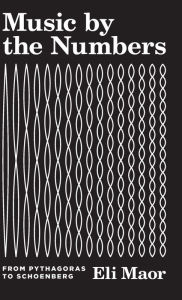Music by the Numbers: From Pythagoras to Schoenberg. Eli Maor

Music-by-the-Numbers-From.pdf
ISBN: 9780691176901 | 176 pages | 5 Mb

- Music by the Numbers: From Pythagoras to Schoenberg
- Eli Maor
- Page: 176
- Format: pdf, ePub, fb2, mobi
- ISBN: 9780691176901
- Publisher: Princeton University Press
Free easy ebooks download Music by the Numbers: From Pythagoras to Schoenberg English version
Chromatic scale - Wikipedia The chromatic scale is a musical scale with twelve pitches, each a semitone above or below its adjacent pitches. As a result, in 12-tone equal temperament the chromatic scale covers all 12 of the available pitches. Thus, there is only one chromatic scale. Moreover, in equal temperament, all the semitones have the same
Music by the Numbers: From Pythagoras to Schoenberg: Amazon.it Scopri Music by the Numbers: From Pythagoras to Schoenberg di Eli Maor: spedizione gratuita per i clienti Prime e per ordini a partire da 29€ spediti da Amazon.
Music by the Numbers - From Pythagoras to Schoenberg - Eli Maor Music is filled with mathematical elements, the works of Bach are often said to possess a math-like logic, and Igor Stravinsky said "musical form is close to mathematics," while Arnold Schoenberg, Iannis Xenakis, and Karlheinz Stockhausen went further, writing music explicitly based on mathematical principles. Yet Eli Maor
Music Composition & Math (numbers/sequences) - Roel's World A blog article about music composition, math, geometry, number sequences, pi, phi, fibonacci, dodecaphony, Twelve-tone technique and more Dodecaphony is a method of musical composition devised by Austrian composer Arnold Schoenberg (1874–1951). The technique is a means of ensuring that all 12 notes of
Amazon | Music by the Numbers: From Pythagoras to - アマゾン Music by the Numbers: From Pythagoras to Schoenberg [Kindle edition] by Eli Maor. Download it once and read it on your Kindle device, PC, phones or tablets. Use features like bookmarks, note taking and highlighting while reading Music bythe Numbers: From Pythagoras to Schoenberg.
Magic numbers: composers and their clandestine codes | Tom The real importance of this discovery, as Kennedy says, is that it allies Plato with the heretical, Pythagorean idea that "mathematical law governed the universe and not Zeus". It's a clandestine code that ties Plato's work to the scientific arcana of music as it was understood by the ancient Greeks. And it may
Music by the Numbers: From Pythagoras to Schoenberg: Eli Maor Music is filled with mathematical elements, the works of Bach are often said to possess a math-like logic, and Igor Stravinsky said "musical form is close to mathematics," while Arnold Schoenberg, Iannis Xenakis, and Karlheinz Stockhausen went further, writing music explicitly based on mathematical principles. Yet Eli Maor
Consonance and dissonance - Wikipedia In music, consonance and dissonance are categorizations of simultaneous or successive sounds. Consonance is associated with sweetness, pleasantness, and acceptability; dissonance is associated with harshness, unpleasantness, or unacceptability. The terms form a structural dichotomy in which they define each other
The Music of the Spheres - The Imaginative Conservative This idea of “the music of the spheres” runs through the history of Western civilization with an extraordinary consistency, even up to the twentieth century. Like Pythagoras, Schoenberg believed that number was the key to the universe. Unlike Pythagoras, he believed his manipulation of number could alter
Library : Is Music Sacred? | Catholic Culture From the music of the spheres to Schoenberg's serialism, Robert Reilly searches for the divine in musical arts. As Aristotle explained in Metaphysics, thePythagoreans "supposed the elements of numbers to be the elements of all things, and the whole heaven to be a musical scale and a number." This was meant literally.
0コメント